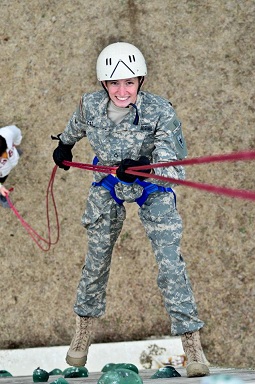Story by: CPT Esperanza Meza, PAO, 19th Regiment and CW2 Janet Schmelzer, PAO, 4th Regiment
2013/02/08
“Training side-by-side with the 19th, our sister regiment in Dallas, and the DFW Medical Group is something we've needed to do for quite a while,” COL Howard N. Palmer, Jr., commander of the 4th Regiment, observed. “It gives us the opportunity to trade best practices, standardize our operations, and to develop professional relationships with the soldiers with whom we may serve in the future. When we are called to state active duty, the training partnership we have now will translate into better service to the citizens of Texas. That's what we're all about.”PFC Rachel Carmickle, 4th Civil Affairs Regiment, rappels from a climbing tower at the Tarleton Challenge Course during the joint exercise of the 4th and 19th Civil Affairs Regiments at Tarleton State University in Stephenville, Texas, on January 11-13, 2013.Photo by PFC Ryan Stephens, TXSG STEPHENVILLE, Texas-- A total of 175 soldiers from the Texas State Guard (TXSG) 4th and 19th Civil Affairs Regiments participated in a joint exercise and training at Tarleton State University (TSU) and Stephenville, Texas, on January 11-13, 2013, as if they were being deployed for a tornado. As part of the joint exercise, the DFW Medical Response Group, TXSG Medical Brigade, provided medical support.
 PFC Rachel Carmickle, 4th Civil Affairs Regiment, rappels from a climbing tower at the Tarleton Challenge Course during the joint exercise of the 4th and 19th Civil Affairs Regiments at Tarleton State University in Stephenville, Texas, on January 11-13, 2013.Photo by PFC Ryan Stephens, TXSG
PFC Rachel Carmickle, 4th Civil Affairs Regiment, rappels from a climbing tower at the Tarleton Challenge Course during the joint exercise of the 4th and 19th Civil Affairs Regiments at Tarleton State University in Stephenville, Texas, on January 11-13, 2013.Photo by PFC Ryan Stephens, TXSG
COL Robert Hastings, commander of 19th Regiment, viewed the weekend as “a multi-faceted exercise that accomplished a number of goals, all directly supporting our mission and Mission Essential Tasks (METL). The ropes and water safety training was intended to build self-confidence and camaraderie. When people accomplish things that they think are impossible, they grow the self-confidence to take on even more difficult tasks.”
The first training mission was to conduct Wide Area Damage Assessment on the TSU campus and in areas of Stephenville including downtown, two city parks, and the local high school. Twenty-five TXSG teams were sent out into target areas to find articles which represented people, clothing, downed electrical lines, and other hazards caused by the tornado. When hazards and persons were located, each team called in the GPS coordinates to the Tactical Operation Center (TOC).
The next day with gusting winds, 26-degree wind chill, and cloudy skies, soldiers braved winter weather to conduct a Search and Rescue mission near Stephenville at the Hunewell Ranch, a 1200-acre area covered with wooded thickets, scrub brush and bottom land. The mission was to find Boy Scouts who had gotten lost during the tornado.
MAJ Wendell Sadler, commander of the 2nd Battalion, 4th Regiment, planned the entire weekend of training. SSG Richard Schilling, Assistant S3, 4th Regiment, along with QRT soldiers from both regiments, set up the high value items, such as rocks, ribbons, campfires, clothing, trash bags, and water bottles, so that the soldiers could track the boys. Both regiments set up separate, fully-operational TOCs on the ranch under very sparse conditions, with the 4th Regiment in an old metal barn with a tractor and the 19th Regiment in an empty storage POD.
During the weekend, soldiers also participated in Water Survival training at the TSU pool. With the TSU ROTC assessing each survival technique, TXSG troops trained to tread water for 5 minutes, remove Load Bearing Equipment before surfacing, and utilize their ACU trousers as flotation devices. On the TSU Challenge Course, soldiers practiced problem solving, team building, and communication skills on both high and low ropes activities.
Several dignitaries participated with the regiments during the weekend. In attendance were TXSG Chief of Staff BG Charles Miller, Stephenville Mayor Kenny Weldon (U.S. Air Force Colonel, retired), Stephenville Fire Chief Jimmy Chew, Tarleton State University President Dr. F. Dominic Dottavio, Robert Comacho (Ombudsman for Congressman Roger Williams, Texas 25th Congressional District), and Donnie Bryant, embedded reporter for the Stephenville Empire-Tribune.